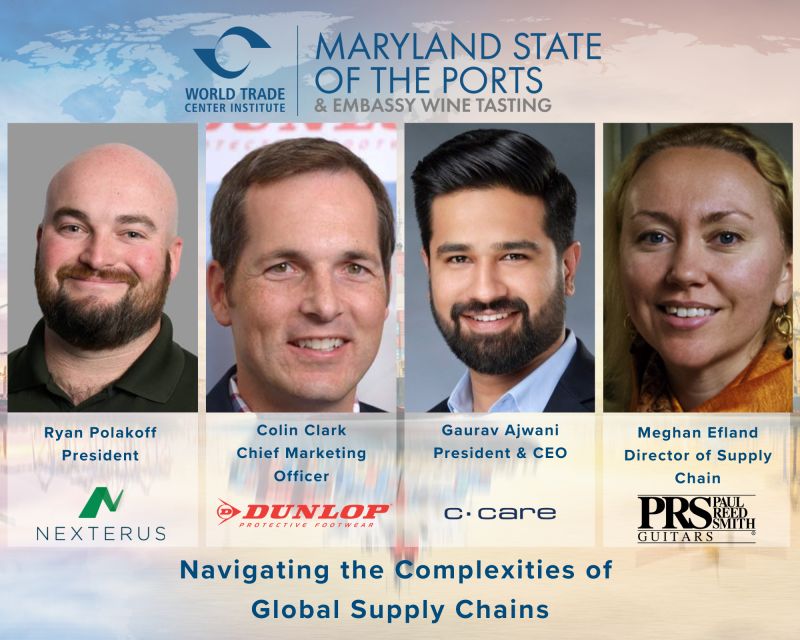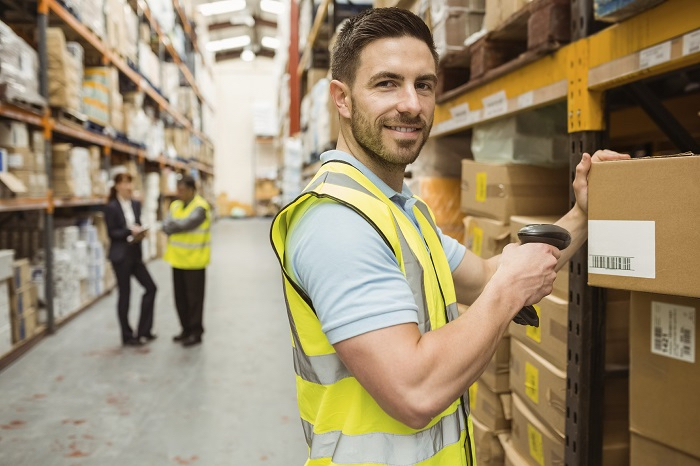December 11, 2023, from the World Trade Center Institute

Host: Ryan Polakoff, President, Nexterus
Panel Participants:
Colin Clark – Chief Marketing Officer, Dunlop Protective Footwear.
Gaurav Ajwani – President & CEO, C-Care LLC
Meghan Efland – Director of Supply Chain – Paul Reed Smith Guitars
Q1. We are a few years removed from the COVID-19 pandemic, and supply chain playbooks have shifted operationally, specifically related to offshoring and nearshoring. How has your company handled this?
Colin: We have manufacturing plants where we make 1.5M pairs of boots a year in Portugal and another in the Netherlands. We were very fortunate that we won a ton of business during the pandemic because we could supply our supply chain locally. It was one truck away, and we supplied two to three days from there. What we’ve seen from our competitors is a lot more onshoring of production. The other pieces to make this product are proprietary compounds and technologies. We had a very stable supply chain that was also hyperlocal. Our PVC plant in Portugal is 110 feet away from our plant, where we get all our materials; the same is true in the USA. We had a very condensed supply chain during that timeframe that helped us grow and be successful. Also, during COVID, people couldn’t do anything but go outside for a hike, and our boots are great for hiking.
Gaurav: That is opposite to what we experienced because travel was closed completely. Cosmetics, especially skincare and haircare, depend a lot on travel. Also, we had a massive backlog of orders, sourcing many ingredients from various parts of the world, and transportation was closed. Packaging was coming from China, and this created a huge bottleneck. We took a considerable loss during COVID. People were not ready to come into the manufacturing facility. Huge production lines handling many kinds of packages were not automated. People were working very close to each other. Many kinds of challenges erupted, and much problem-solving and learning started then.
Meghan: Typically, if there’s economic uncertainty, a guitar is the last thing somebody thinks about. We offer a luxury product and are also higher in our price point. We have many people at home; they’ve always wanted to play guitar, or they have been dreaming about a guitar, and you have a lot of other things going on. Federal money was returned to many people in the US. We also offered creative financing options with 0% financing for 12 to 24 months. We were a non-essential business and were shut down for almost two months. So when we came back, the factory was ready to go. We had many sales orders. Our biggest challenge is having two OEM factories in Asia. Many different things were changing there, whether it was transportation lanes or their federal governments. We do have a solid dual-sourcing strategy. So, we typically try to have a domestic and overseas source for everything and strong relationships with vendors and suppliers. We were on calls with them, constantly trying to see what was happening. You know what can we do? How can we work with them? How do we make this work? Everybody was in it, trying to achieve the same goal, but it was more challenging than other times. It’s interesting that during COVID, people went outside for hikes. They learned how to play guitar in the house, and then, as soon as COVID ended, everybody went out and needed cosmetics. It’s the inverse of what happened here.
Q2. Three years removed from the pandemic, we've learned many lessons in the supply chain. There's been a philosophical shift in classic supply chain methodology, such as lean, and companies are approaching demand forecasting and demand planning differently. What do these things now mean for your companies, particularly in 2024 and beyond? What's changed that may not serve you well?
Meghan: For us, we come back from COVID, and the music industry is surging. Customers are ordering, then things start slowing down. Many retail customers reacted slowly and had cash flow issues, so I had to inventory differently from the textbook theories. We had no sales during the 2021-2022 timeframe. Then, as markets opened, we saw a massive increase in sales from our retailers. Everybody was shopping around, everybody started to travel. People were buying a whole lot. We had issues around procuring the chemicals because of long lead times since boats were still congested. Many supply chain issues on the European side challenged us. But now we have too much inventory, and predictive analysis on demand is way off the charts. Suddenly, during the close of last year’s last quarter, we realized they had to cut down seriously on costs. Inventory must be reduced, so sales have gone down significantly this year.
Q3. There's been no shortage of volatile activity in the freight market, particularly in the logistics sector. This year, we've seen large companies, like Yellow, go bankrupt. Digital transportation brokers went bankrupt. The parcel industry was threatened with strikes. There have been port delays that have continued. There have been sourcing challenges. These touch, impact, and affect the interior and the exterior of companies’ supply chains. What are you looking to do to optimize and mitigate transportation costs?
Colin: This is the part where I say we partnered with Nexterus. One of our strengths is producing locally, serving the business, and shipping locally. During COVID and afterward, pricing went out of whack, so some of our business turned upside down. We’ve been getting more brilliant with how and where we ship, considering how many pairs of boots we can put in a box. How many pairs of shoes will fit on a pallet? What are our minimum order quantities? We’ve taken a holistic view of the supply chain, including transportation. We didn’t have the expertise, so we partnered with Nexterus. We’ve learned a ton, and Nexterus has helped us evolve how to ship our products and service our customers. So, the first big key point was how do we get more competent at it? How do we get more productive at it? And then in the end our customers appreciate it. The number one call our customer service leaders hear is when will my order arrive and what’s my tracking number? So, working with Nexterus, we’ve eliminated many of these calls, and it’s been unbelievably successful for the business.
Gaurav: Optimizing transportation costs has been one of our focuses for 2024. We’ve partnered with Nexterus because of their expertise, whether through optimizing and consolidating lanes or providing us with predictive analytics around transportation. As manufacturers, we’re so engrossed in machine efficiencies and labor efficiencies that optimizing transportation becomes a second thought, and we end up paying the bills without even realizing there was a ton of opportunity to consolidate our shipments. We bring chemicals to the factory daily, so why do I have to bring chemicals from the same vendor five different times? Why can’t I consolidate all five shipments into one shipment? We did this manually by considering lead time, but lots of data needed to be simplified. So, we looked for a partner to give us the analytics and say, “Hey, you have the same shipment from the same guy for 15 times this month. Could you have consolidated this into two shipments?” Yes, we could. Some extra cash might be involved, but consolidation has a considerable upside. Having good optimization tools around your transportation can be a game changer. From a manufacturer’s standpoint, we know efficiencies, run rates, and everything inside the plant. There’s so much data and so much expertise around that. But we don’t know shipping. We ship products but have yet to spend much time focusing on transportation. We don’t know what we don’t know, so we found experts in the space – Nexterus. Finding that outside partner to help was great.
Meghan: We deal with a genus and species of wood that only comes from one place in the world, so have transportation requirements to many places in the middle of nowhere. Some of our components are only made in one place in the world. We needed to be aware of what’s going on and what’s coming up and being able to plan for it. We went from $36,000 for a 40-foot container to <$3000. COVID and everything that happened within our supply chain made our business more aware of supply chain and transportation costs. We didn’t have visibility, but now it’s become a significant focus of the business. We have a handful of different partners that we’re working with. We work with one that does analytics on our UPS and FedEx – Are we overcharged? How do our contracts look to companies of similar size? They helped us renegotiate the contract so that our rates are better. They can also tell us that if we do the same thing we did over the last 12 months in this contract, we can save $130,000. Shapiro has been a great partner. They’re our freight forwarder. Their fantastic team keeps us in the loop and tells us what’s going on with our shipments so that we can make the best decisions. We also use a bolt-on tool to our ERP called Pacejet Shipping, which manages our freight contracts and tells us the best prices for each shipment, making it easier for our shipping department to make the best decisions. It also makes it easy for us to change from UPS to FedEx or a different trucking company. It makes that much more simplistic than it was in the past. We’re talking with our reps about ways to save on transportation to our end customers. We’re going to start working with Nexterus to get a baseline. One of our challenges is that we do a lot of FedEx and UPS parcel shipments, but we also do LTL freight, so trying to tie all that data together is a complex model. That’s not our expertise. So, we hired somebody with that expertise, and it’s worth the money. Our business is seeing the value in it.
Q4. The supply chain has definitively moved from the back room to the boardroom. For most companies, it's now part of business strategy. How is supply chain management different at your companies' organizational levels? What does it mean now compared to what it used to be?
Colin: We ship boots to 95 countries throughout the world. With price increases in freight, our Australia and Latin America business slowed down because freight became cost prohibitive. So, the supply chain has become a considerable discussion within the boardroom. It’s part of the go-to-market strategy. It’s part of what products we sell to certain countries. The supply chain touches almost every single piece of the business. We’ve added a bigger team on supply chain, more experts, and more tools to handle it.
Gaurav: The supply chain has now taken center stage in most businesses. People have realized that the supply chain is not just another function in the hierarchy of organizations, but it is the center of all the departments in the business. Whether you talk about pricing your finished goods, raw materials, and transportation, understanding the supply chain is crucial to making the right decisions. When I studied supply chain in 2010, the word ” supply chain ” was used sparingly. You had to explain the difference between supply chain and manufacturing. People from different operations within the business used the words “supply chain” to mean different things. Now, in all discussions in the boardroom, every other word is about supply chain. As a supply chain practitioner, seeing that supply chains have impacted many fields is encouraging. You hear about all the human efforts being made when earthquakes happen. Even social networks discuss supply chains. Everyone has come to understand the importance of the term.
Meghan: Pre-COVID, many people didn’t know what a supply chain was. I’d introduce myself as working in the supply chain. Instantly, people would go on to the next question with no interest. Today, it’s crucial to our daily lives, and people are increasingly thinking about it. Our core competency is making guitars, so we know much about manufacturing. We put much of the focus on hiring a new engineer, or will we get this new piece of equipment for the production line? And now, it’s more about how we get products from here to there and how this will financially impact us. If we move to this cost center, how are the tariffs and things like that involved? A supply chain is more of a web. It’s so invasive in our companies, and it impacts every single part of what we’re doing and the strategy of our business. Pre-pandemic, I used to say that those of us in the supply chain are in the best industry no one’s ever heard of. That’s not the case anymore.


